I am listening to my 0.4x Karlsonator and it sounds fantastic with rich full bass by virtue of its design as a mass loaded tapered quarter wave transmission line (ML-TQWT) design. I think it sounds better than the Hypercube (huge sound from very small box, lots of bass and great dispersion) and it very easy to build. You should give it a try. I tried the Hypercube so in fairness, you should give the mini Karlsonator a try. Look at how popular the thread is and how many happy builds there have been.
http://www.diyaudio.com/forums/full-range/239338-mini-karlsonator-0-53x-dual-tc9fds.html
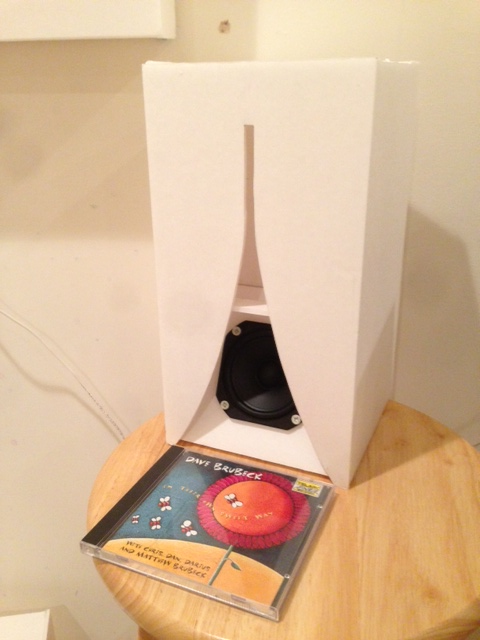
That's really cool. I see you have a dual driver version as well. Do you have any measurements of the .4x using the Vifa 3.5"?
In probably have the measurement somewhere on my hard drive. I will have to dig it up. If I recall correctly, it looks similar to the 3FE25 but with slightly less top end and overall 6dB less sensitive.
Equal sided dodecahedron more simple?
Interesting link on post #228 on YouTube. "031 How to Build a Dodecahedron"
If you make up jigs on a saw, there are only 2 angles to set up. This should makes an equal sided dodecahedron that simply fits together perfectly.
Would this not make construction more simple?
I see no reason why the performance of the final result will be significantly different.
The lovely thing about these designs is that baffle step diffraction is minimized and no parallel internal surfaces to set up standing waves--which accounts for the rather good results one gets from the drivers.
I am a bit concerned about the discussion of using materials in the sides that add resonances to the system. I have always felt that speakers should have a minimum of resonances, as should its enclosure. That is the only way to accurately reproduce true hifi sound.
If you think of a speaker as a musical instrument, then you need to choose your materials as a violin maker would. This rules out plywood and MDF. Solid sitka spuce sheets might be better.
Interesting link on post #228 on YouTube. "031 How to Build a Dodecahedron"
If you make up jigs on a saw, there are only 2 angles to set up. This should makes an equal sided dodecahedron that simply fits together perfectly.
Would this not make construction more simple?
I see no reason why the performance of the final result will be significantly different.
The lovely thing about these designs is that baffle step diffraction is minimized and no parallel internal surfaces to set up standing waves--which accounts for the rather good results one gets from the drivers.
I am a bit concerned about the discussion of using materials in the sides that add resonances to the system. I have always felt that speakers should have a minimum of resonances, as should its enclosure. That is the only way to accurately reproduce true hifi sound.
If you think of a speaker as a musical instrument, then you need to choose your materials as a violin maker would. This rules out plywood and MDF. Solid sitka spuce sheets might be better.
I think a spruce walled Hypercube would be great sounding and look very cool. Where does one buy instrument grade spruce?
Where does one buy instrument grade spruce?
A specialist at great price,
You could try a model aeroplane shop, gets used for wing spars and such in pre-cut strip and you can buy it in 3" or 4" wide by 36" or 48" sheets, I've seen it as thick as 3/8th's inch, which can be jointed.
Interesting link on post #228 on YouTube. "031 How to Build a Dodecahedron"
If you make up jigs on a saw, there are only 2 angles to set up. This should makes an equal sided dodecahedron that simply fits together perfectly.
Would this not make construction more simple?
I see no reason why the performance of the final result will be significantly different.
The lovely thing about these designs is that baffle step diffraction is minimized and no parallel internal surfaces to set up standing waves--which accounts for the rather good results one gets from the drivers.
I am a bit concerned about the discussion of using materials in the sides that add resonances to the system. I have always felt that speakers should have a minimum of resonances, as should its enclosure. That is the only way to accurately reproduce true hifi sound.
If you think of a speaker as a musical instrument, then you need to choose your materials as a violin maker would. This rules out plywood and MDF. Solid sitka spuce sheets might be better.
Hi Cornelis,
The enclosure this thread is based on originates from a rhombic dodecahedron rather than a pentagonal dodecahedron. The rhombic dodecahedron is the inside-out version of an expanding or collapsing cube. Indeed, a cube can fit perfectly inside of a pentagonal deodecahedron but I don't know how such a shape would mold the backwave so I can't say for sure that the performance would be similar. The square-truncation rhombic dodecahedron speaker enclosure puts the driver on a displacement anti-node which is less destructive to it's intended motion.
I'm not so sure that the avoidance of parallel surfaces is the name of the game here; The rhombic dodecahedron has four parallel rhombi whose major axes make up a square, yet the standing waves that we would expect to be associated with this particular dimension are curiously missing in action (or at least very low in amplitude) in my measurements.
As far as added resonances and "accuracy" go, some would say that the enclosure should not participate sonically. Others would say that the ideal loudspeaker would radiate sound (in phase) from all directions. It seems that the rhombic dodecahedron might offer us the latter possibility as an added bonus to its clean impulse response and relatively low harmonic distortion.
Personally, I don't think of the hypercube speaker as a musical instrument because the enclosure doesn't amplify the sound like the body of a musical instrument does; I think a horn speaker probably fits this description better than a hypercube speaker. That being said, I look forward to hearing a paper cone - alnico magnet - thin spruce enclosure hypercube speaker one day.
--Greg
gmad, I think you're right, speaker enclosures should not resonate and amplify sound like the sound box of a stringed instrument. The selection of speaker material and geometry should be based on keeping resonant modes as high in frequency (hopefully beyond the audible range) and as small in amplitude as possible. The rhombic dodecahedron is great geometry because it keeps the panels small and the enclosure very stiff, resulting in very high frequency modes. Construction material should be stiff and heavy. Heavy materials would reduce vibration amplitude, however it would also bring mode frequencies down, so it's all a balancing act as most things in engineering are.
Interesting fact, in vibration testing many fixtures are made of magnesium because it's stiffness to weight ratio is much higher than other materials. This makes the fixture resonant modes higher in frequency and the reduced weight contributes less to the response of the system under test. (This example should not be confused with good speaker building practice, it's only to demonstrate that a balance of material properties are important to good design.)
In regards to the rhombic dodecahedron radiating sound, as I've stated before, I still think the data only shows that the small baffle eliminates baffle step effects and we're seeing the natural dispersion pattern of the driver.
Interesting fact, in vibration testing many fixtures are made of magnesium because it's stiffness to weight ratio is much higher than other materials. This makes the fixture resonant modes higher in frequency and the reduced weight contributes less to the response of the system under test. (This example should not be confused with good speaker building practice, it's only to demonstrate that a balance of material properties are important to good design.)
In regards to the rhombic dodecahedron radiating sound, as I've stated before, I still think the data only shows that the small baffle eliminates baffle step effects and we're seeing the natural dispersion pattern of the driver.
xrk971,
I'm very interested in the Karlsonator design. Where is a good place to learn more about operation theory and design equations?
I think I may need to make one of your Karlsonators along with the hypercube for comparison with you're foam board technique.
I'm very interested in the Karlsonator design. Where is a good place to learn more about operation theory and design equations?
I think I may need to make one of your Karlsonators along with the hypercube for comparison with you're foam board technique.
xrk971,
I'm very interested in the Karlsonator design. Where is a good place to learn more about operation theory and design equations?
I think I may need to make one of your Karlsonators along with the hypercube for comparison with you're foam board technique.
In the linked 0.53x Karlsonator thread there is more info, but the model for the Karlson aperture is described in the Speaker that Kicks Butt thread. I then took the aperture portion of the K15 model and combined it with a model for Karlsonator (a ML-TQWT TL) speaker that I developed in AkAbak. The K aperture model is based on a study I did to put many vent holes of varying size along the length of a TL done in the Flute TL thread. Basically I am using 9 to 14 rectangular vent holes with width prescribed by the Karlson aperture curve function. The interested modeler should be able to piece this together for their own model - but I have not released mine publicly. Don't mean to be cryptic but there is a lot of work invested in the model on my part. I will glad to assist you with making your own AkAbak script in the other threads if you want.
The relevant threads are here:
http://www.diyaudio.com/forums/full-range/237384-flute-pipe-tl.html
http://www.diyaudio.com/forums/full-range/213594-karlson-10.html#post3528706
http://www.diyaudio.com/forums/full-range/237948-speaker-kicks-butt-large-spaces.html
Here is a schematic of basic idea on how the aperture was modeled (in a K15):
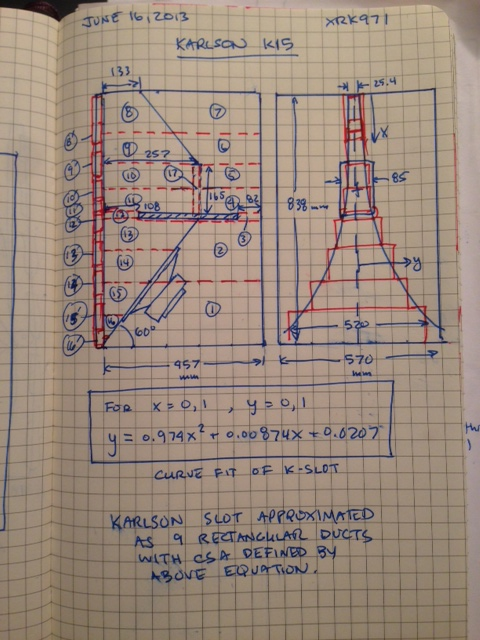
Last edited:
In regards to the rhombic dodecahedron radiating sound, as I've stated before, I still think the data only shows that the small baffle eliminates baffle step effects and we're seeing the natural dispersion pattern of the driver.
I was just looking at xrk971's hypercube polar plot (post #190). Correct me if I'm wrong, but if we approximate the enclosure as a 6.5" sphere, shouldn't we see with respect to the 180deg measurement a 6db treble shelf cut with a 700hz center frequency? Like my own measurements, his response is pretty uniform around the enclosure up to the treble range. Also, my 180deg measurement without stuffing shows more highs than with stuffing.
gmad, thanks for the comment.
You're right about the effect from in front of the speaker. But I just can't find any information about how that translates to sound at the sides. I just don't have much time to devote to proving it with math it right now (and I didn't want to just not respond), and I don't have a test setup so I can't find it experimentally. My understanding is that total acoustic energy must remain the same, so if there is a drop in response from the front it translates to more sound at the sides. I'm just not sure about the expected levels at the sides. I've been tricked before by trying to use intuition on logarithmic scales, I'm hesitant to agree with your assessment without equations or data to back it up.
The way I've been tricked has to do with the fact that a 6 dB increase at a high level is much larger than a 6dB increase at a low level. For example, if you have a sound pressure level of say 90 dB, and you take 6 dB (about half) of that energy and direct that into a space (of equivalent size) that has a much lower level, lets say 70 dB, then I calculate the increase is 15.6 dB or the new level is 85.6 dB. Not a very realistic example, but I hope it makes the point.
You're right about the effect from in front of the speaker. But I just can't find any information about how that translates to sound at the sides. I just don't have much time to devote to proving it with math it right now (and I didn't want to just not respond), and I don't have a test setup so I can't find it experimentally. My understanding is that total acoustic energy must remain the same, so if there is a drop in response from the front it translates to more sound at the sides. I'm just not sure about the expected levels at the sides. I've been tricked before by trying to use intuition on logarithmic scales, I'm hesitant to agree with your assessment without equations or data to back it up.
The way I've been tricked has to do with the fact that a 6 dB increase at a high level is much larger than a 6dB increase at a low level. For example, if you have a sound pressure level of say 90 dB, and you take 6 dB (about half) of that energy and direct that into a space (of equivalent size) that has a much lower level, lets say 70 dB, then I calculate the increase is 15.6 dB or the new level is 85.6 dB. Not a very realistic example, but I hope it makes the point.
Hi MuddJester,
To further complicate things there is the issue of near-field vs. far-field measurements. My polar plot is a near-field measurement. xrk's measurements were taken from a bit farther away but I'm not sure exactly how far. We did however get similar results in the treble range. Measurement distance aside, and with respect to xrk's polar plot (particularly the 180 deg. measurement), should 3khz be "wrapping around" a 6.5" enclosure just as easily as the low frequencies?
To further complicate things there is the issue of near-field vs. far-field measurements. My polar plot is a near-field measurement. xrk's measurements were taken from a bit farther away but I'm not sure exactly how far. We did however get similar results in the treble range. Measurement distance aside, and with respect to xrk's polar plot (particularly the 180 deg. measurement), should 3khz be "wrapping around" a 6.5" enclosure just as easily as the low frequencies?
I was just looking at xrk971's hypercube polar plot (post #190). Correct me if I'm wrong, but if we approximate the enclosure as a 6.5" sphere, shouldn't we see with respect to the 180deg measurement a 6db treble shelf cut with a 700hz center frequency? Like my own measurements, his response is pretty uniform around the enclosure up to the treble range. Also, my 180deg measurement without stuffing shows more highs than with stuffing.
I see a totally normal baffle step in that plot at 0 degrees at about 900Hz, which is also what I would expect. Generally HF response falls away off axis, and I wouldn't expect to see a distinct baffle step off axis. This is one case where some 1/3 octave smoothing would actually make things clearer!
A 3 or 4 db shelf instead of 6db is also not unusual if measured indoors.
While the polyhedra likely does have better diffraction characteristics than a box, it still has edges. I suspect we are still seeing some real world 'wiggle' around the baffle corner freq rather than the hypothetical perfect roll off of a sphere.
That's really cool. I see you have a dual driver version as well. Do you have any measurements of the .4x using the Vifa 3.5"?
Here are some measurments of the Vifa in a 0.4x Karlsonator that I just built.
http://www.diyaudio.com/forums/full-range/239338-mini-karlsonator-0-53x-dual-tc9fds-115.html#post4140593
With and without wings:
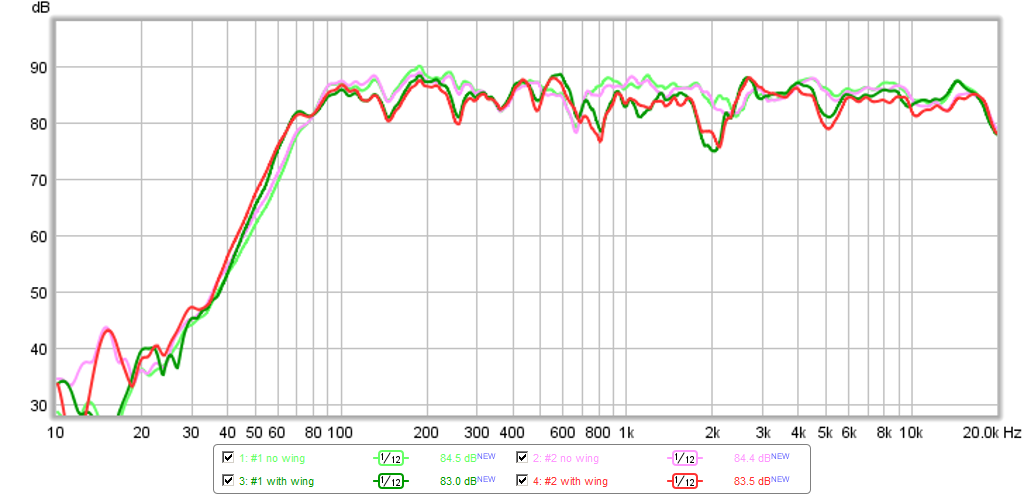
Min Phase:
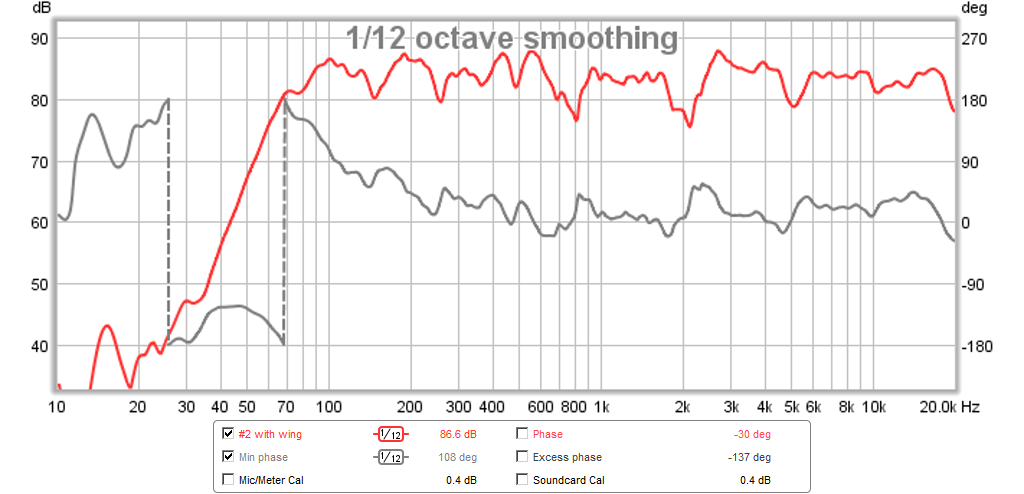
Impulse:
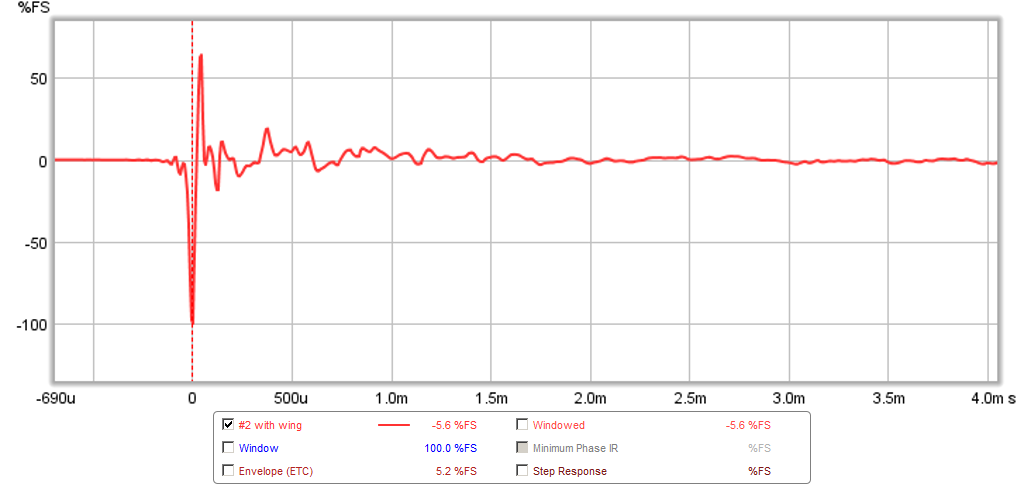
This site gives the goriest dimension details about all kinds of polygons.
The Rhombic Dodecahedron
I have always been fascinated by polygons, especially dodecahedron. I have built a few of them in small size. I'll check out the links your provided here Greg.
The Rhombic Dodecahedron
I have always been fascinated by polygons, especially dodecahedron. I have built a few of them in small size. I'll check out the links your provided here Greg.
Greg B and MuddJester,
Thanks for your input and I will continue to ponder this.
Richidoo,
Thanks for checking this out. I think this shape makes for a great enclosure. The quality of bass reproduction alone makes it special to me.
Thanks for your input and I will continue to ponder this.
Richidoo,
Thanks for checking this out. I think this shape makes for a great enclosure. The quality of bass reproduction alone makes it special to me.
Greg,
Thanks for the info! This is what I was thinking was the case, which means that standard enclosure construction techniques should be applied. The natural stiffness of the enclosure probably means no bracing is needed, but the material should still be the thickest tolerable stiff wood like MDF. But I'm afraid of confirmation bias so I'd still like to hear from others or see any data that can support this.
gmad,
There was some talk a while ago about measuring the 180° response with a large flat baffle attached to the front baffle to block direct radiation from the speaker cone. Is this a possibility? xrk971, you did that measurement with the speaker facing down, but it looks like the absorber under the speaker was a towel then carpet and I have doubts about the effectiveness of that measurement. Any way this measurement could be re-done with an absorption panel, the kind filled with fiberglass or mineral wool?
I'm starting to feel like I'm beating a dead horse, please feel free to tell me if you agree, but I'd love to have good scientific rigor (and consensus) on this point given previous claims about the behavior of this enclosure.
Thanks for the info! This is what I was thinking was the case, which means that standard enclosure construction techniques should be applied. The natural stiffness of the enclosure probably means no bracing is needed, but the material should still be the thickest tolerable stiff wood like MDF. But I'm afraid of confirmation bias so I'd still like to hear from others or see any data that can support this.
gmad,
There was some talk a while ago about measuring the 180° response with a large flat baffle attached to the front baffle to block direct radiation from the speaker cone. Is this a possibility? xrk971, you did that measurement with the speaker facing down, but it looks like the absorber under the speaker was a towel then carpet and I have doubts about the effectiveness of that measurement. Any way this measurement could be re-done with an absorption panel, the kind filled with fiberglass or mineral wool?
I'm starting to feel like I'm beating a dead horse, please feel free to tell me if you agree, but I'd love to have good scientific rigor (and consensus) on this point given previous claims about the behavior of this enclosure.
Hi MuddJester,
I don't know how quickly I could do a measurement like that. Maybe a very long 4" stuffed tube could be used as well? The speakers *seem* to have a more "omni" sound but I'll be happy to retract the claim until it can be objectively proven.
What I can say for sure right now is that relative to the equivalent volume sealed box (which has 2x the panel thickness) the hypercubes have faster decay, a bit more output in the bottom octaves and quite a bit less harmonic distortion in the lowest octave.
I'm sure these qualities along with improved diffraction could at the very least help to explain the improved sense of ambiance with the hypercubes.
Thank you as always for your help with this.
I don't know how quickly I could do a measurement like that. Maybe a very long 4" stuffed tube could be used as well? The speakers *seem* to have a more "omni" sound but I'll be happy to retract the claim until it can be objectively proven.
What I can say for sure right now is that relative to the equivalent volume sealed box (which has 2x the panel thickness) the hypercubes have faster decay, a bit more output in the bottom octaves and quite a bit less harmonic distortion in the lowest octave.
I'm sure these qualities along with improved diffraction could at the very least help to explain the improved sense of ambiance with the hypercubes.
Thank you as always for your help with this.
I feel free 🙂.....and agree MuddJester, but base this only on diy own experience and thoughts, if science pop in that point to other direction i am ready to accept/swallow. Making box resonate by purpose i don't think take sound reproduction nearer to the original track mix mastered in studio, and won't do it myself...........I'm starting to feel like I'm beating a dead horse, please feel free to tell me if you agree, but I'd love to have good scientific rigor (and consensus) on this point given previous claims about the behavior of this enclosure.
That said because no speaker reproduce square waves 20-20kHz at every seat in real world rooms, i respect/accept people's choice and call it what you want effects/distortion/musicality/colouring/add-layer to get more enjoyable sound.
- Status
- Not open for further replies.
- Home
- Loudspeakers
- Full Range
- Hypercube Loudspeakers